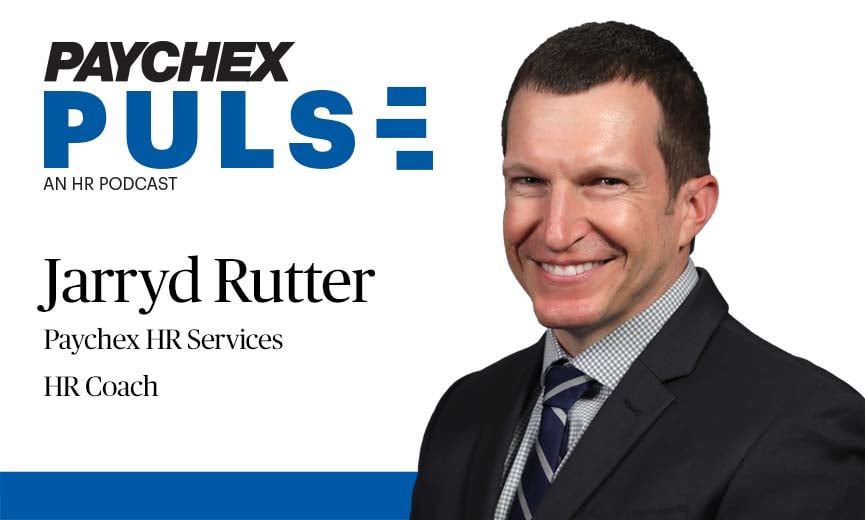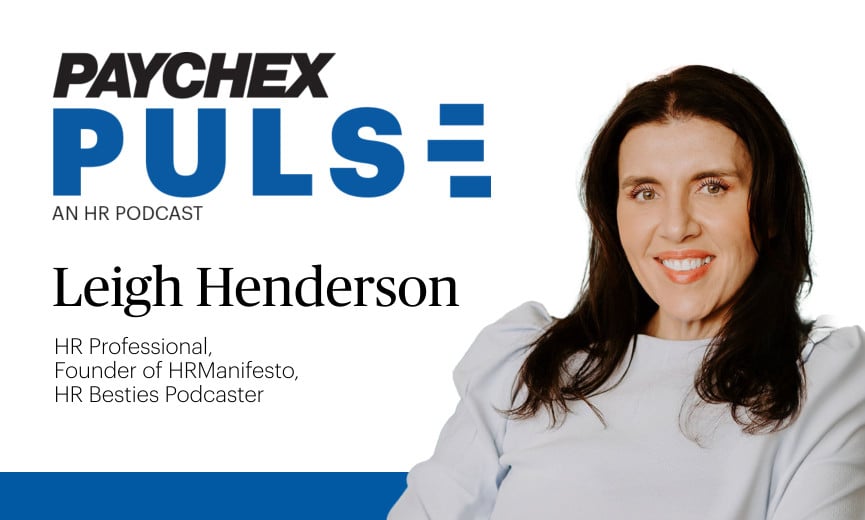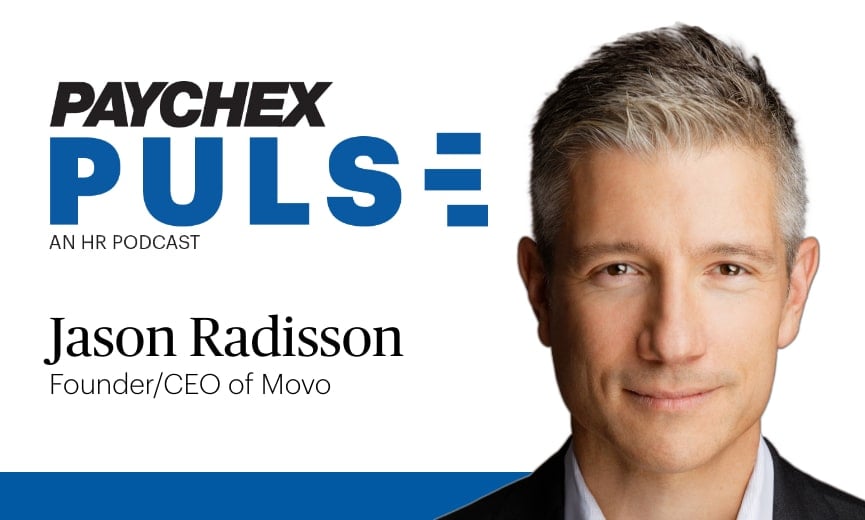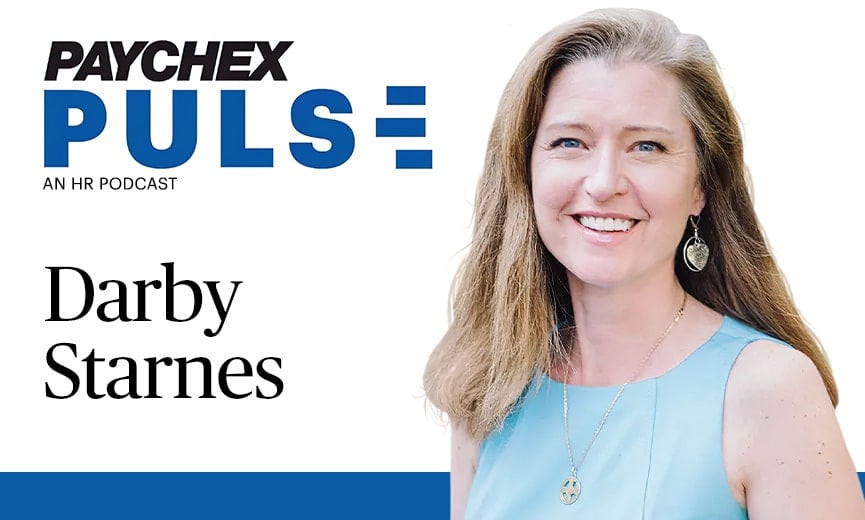Become a Talent Magnet: The Powerful Pull of Better Benefits

Podcast •

Watch
Summary
Paychex Human Resources Coach Jarryd Rutter joins the podcast to share the benefits needed today to attract, nurture, and keep great employees. He and host Rob Parsons explore how to offer benefits that matter to different employee populations (generation, job type, etc.), why communicating an employee’s total rewards package is so important, the impact of self-service technology on benefits, and the disconnect between what employees want and what employers think they do.
Topics include:
00:00 – Welcome Jarryd Rutter
01:23 – Benefits as a differentiator
02:04 – Communicating a total rewards package
05:36 – Emerging trends in employee wellbeing
08:56 – Integrating technology and benefits
12:24 – A year-round approach to benefits
14:54 – Career growth and pathing as a benefit
16:38 – Wrap up
WEBINAR: Be a Talent Magnet: Strategies for Finding and Keeping Great People - watch now
Discover more employee benefits trends for 2023.
What you need to know about state-assisted retirement plans.
Need help navigating the complex world of employee benefits? Enlist a benefits broker.
Find out how Paychex Professional Employer Organization (PEO) Services can help you offer the benefits that keep employees with your business.
View Transcript
Rob Parsons (00:00):
Welcome to Season 4 of Paychex PULSE, an HR podcast where HR professionals can find great insights on today's top issues and be inspired to build and lead effective teams in a healthier workplace.
Rob Parsons (00:19):
Hey everyone, Rob Parsons here. Welcome back to PULSE. Today we're joined by Jarryd Rutter. Jarryd has worked in the HR field for over 20 years. He currently works as an HR coach, collaborating with our HR business partners who support Paychex clients. Today we're going to talk about how you can turn your company into a talent magnet. Jarryd, welcome back to the podcast.
Jarryd Rutter (00:44):
Yeah, thanks for having me, Rob. Great to be back.
Rob Parsons (00:46):
This is great, and an interesting topic since it was just a year ago today that we were talking about boomerang employees, how maybe the grass isn't always greener, and a lot of that had to do with benefits. So, I wanted to talk today about benefits.
Jarryd Rutter (01:04):
Love it, to the day, one year to the day.
Rob Parsons (01:08):
One year to the day. So, we just finished fielding our 7th Annual Pulse of HR Survey, and improving recruitment and talent acquisition was again a top HR leader goal. I'm sure you don't find that to be a surprise at all.
Jarryd Rutter (01:23):
No, not at all. And in various forms of surveys, like four years in a row, the two main biggest challenges have been competitive comp and benefits and attracting and retaining talent. So, that's in no way, shape, or form, a surprise. And that kind of has, I would say, grown even more post pandemic or I guess post, knock on wood, whatever…But, just because of the Great Resignation and what that has done to the workplace and virtual and hybrid workplaces. So, it's a different world than we lived in four years ago.
Rob Parsons (02:04):
We're definitely seeing that. And something we're also seeing, or what the survey revealed was benefits are a huge differentiator. I think more so than ever. It used to be benefits were kind of, there was some basic table stakes, you had them and then maybe there was a couple perks here and there, but in general, benefits were really not a huge part of the conversation. And I think what we're seeing now is more creative use of benefits, but I even want to start with putting a dollar value on those benefits and actually communicating that to candidates, to employees, what that total rewards really is. Can you dig into that a little bit for us?
Jarryd Rutter (02:44):
Yeah, and having a form of technology to help you do that is always going to be beneficial. For example, a total compensation, even something as simple as a pie chart, our technology offers that, and it's growing. The number of benefits that are necessary to really keep employees happy is growing. So traditionally, people focused on health insurance, dental, and if you had a retirement plan, fantastic. Those cost money to administrate. I don't know that those were always communicated, the expenses I mean, to employees because it was just a given and a whatever. Now, if you really look at some of the numbers, and I don't have all these numbers in front of me, but like 85%, give or take, of employees surveyed have said that they would be more willing to stay with their current employer if their benefit plan met their needs. And what meets the needs of an employee base, again, as I mentioned, is very different now.
And there are certain things that need to be taken into consideration. Generational differences, differences between blue collar, white collar, overall demographics, but not only offering various different types of benefits, but trying to give some context to employees as to what it actually costs to provide those benefits so that people don't get so hyper focused on, I make whatever, $40,000 a year, and that's all they have their focus on. We saw a lot of increase in wages during the Great Resignation and you can't keep raising wages forever, particularly now there's this balance between inflation and employer costs going up and employees at the same time being like, okay, whatever. It's costing me more to fill up my car, go buy milk, eggs, all of the above. So, trying to give some perspective as to we have all of these different benefits. If you're pushing up into the 20s and 30s as an employer, good call. That does usually result in stickier employees and having the ability to show, we pay you this, it actually costs us this to employ you. So, we have all these benefits, take advantage of them.
Rob Parsons (05:16):
And I could even see adjusting my language. I'm investing in you Jarryd, I'm investing in you with this much pay, I'm investing in you with these kinds of benefits that I have available. It's not all about me, it's what I'm putting into you because I do want you to stay.
Jarryd Rutter (05:36):
Investing in employees and also showing employees that you care. That has started to look very different as well. There's been more of a focus or a lean on health and wellness and wellbeing and really some of the benefits that maybe weren't offered traditionally 10, 15 plus years ago are becoming more relevant or pertinent because of that focus. So, I mean EAP plans have been around for a really long time. I don't know that employers traditionally have really done a great job of educating employees as to what it is, how they can benefit from them. Legal programs, just kind of a peace of mind as if something happens, I have this option to lean on. Gym memberships, we want to keep people healthy and that can, in some situations, be onsite gyms. We're seeing a lot of childcare assistance, onsite childcare, helping people through an EAP for example, to find childcare options for employees, and that still is something that's rather limited.
It was a big, big problem during the pandemic and it still is and one that I really find to be interesting. I had a conversation at a conference with a woman last week and one of her main focuses, and I applaud her because this is something that I find to be pretty cool, is having a pet-friendly environment, creating pet-friendly policies, bringing your pet to work, pet insurance, and even something as simple as doggy daycare options or reimbursements. During the pandemic, there was this surge of people working from home that have never worked from home and people running out and getting pets because they were home all day every day. And people are now being called back into the office and people are coming to the realization of, oh, well I have pet A and pet B, they're going to lose their minds if I'm gone 12 hours a day. And I have two dogs, I love dogs and I've worked hybrid, I guess you could say for a really, really long time. But, if I suddenly, my wife and I were gone 12 hours a day, they wouldn't do well with it. So, people are coming to this place in which they kind of have to choose, do I want to keep my job, or do I need to surrender my pet? So, all of these different things that are maybe a little bit outside the box, cleaning service, anything to help maintain a, work-life balance is a term that isn't really used quite as often but I'll use it today just for simplicity purposes, but making sure that you are recognizing that life isn't always easy. There's a lot of complications and challenges that come up in life. We want to also show that we care, recognize that, and these are the different things that we're trying to do to help that above and beyond just investing in people and it is a form of investment, frankly.
Rob Parsons (08:56):
You brought up so many questions there. I want to talk about this idea of navigating and communicating some of these programs, these things you mentioned, they're out of the box, they're creative, probably not easy to package into a little job description or even for a manager to touch on during an interview. This is really maybe about retaining my people, keeping them engaged, keeping them healthy. Talk to me a little bit about this communicating, helping people navigate and helping employees really understand everything you're trying to do as an employer who is really trying to invest and up this level of care and this level of wellness.
Jarryd Rutter (09:35):
Communication and education is incredibly important. Employers should never assume that their employees know that they understand the benefits that are being offered, and that can vary fairly greatly from your baby boomers who probably based on years and years and years of experience, having a stronger understanding of what benefits traditionally are, how they work. Whereas Gen Z coming into the workplace who don't really have a lot of exposure to it, tend to struggle a little bit more. Gen Z is looking primarily for forms of technology that can be apps, ways to enroll online, ways to monitor or manage their benefits online. It's not as big of a preference for boomers, but the data's starting to show that even boomers are leaning more on technology. So as an employer, it's important to recognize that and really try to find technology that's going to allow you to promote your benefits, educate your employees as to what the benefits are, how to utilize them, whether it makes sense to them or doesn't.
And that can be an LMS (Learning Management System) that can be incorporating videos or interactive types of solutions into an LMS or self-service giving employees the ability to enroll online, make changes online in addition to it being an awesome option for employees but, it does also show employees that, hey, we're evolving with the times and we want to make this as easy and seamless as possible for everyone. At the same time, the reality is it can save time and money for the employer because their employees are able to do these things on their own versus working through the employer the entire time.
And if it makes sense, supplementing technology with a benefits expert or a consultant or, I mean we at Paychex have HR Business Partners that can help with a lot of these things and navigating how to get them rolled out to employees and helping employees to understand 401(k) consultants to make sure that you have a plan design in your 401(k) that makes sense. Health and benefit reps to help with insurance plans and even a PEO, which allows for an employer to really hone in on the various different types of plans that are offered through the PEO, these are going to be the ones that are going to make sense for us based on our demographics, usage, so on and so forth.
Rob Parsons (12:24):
I like how you opened up with talking about how things have evolved. Used to be, I talked about benefits, or I thought about benefits in November around annual enrollment, that was it. I signed up for the next year and then quite frankly, they were off my radar unless something came up. Are you finding clients and are you helping clients talk about benefits all year long and really trying to drive engagement and usage?
Jarryd Rutter (12:49):
Yeah, fairly regularly because whereas to your point Rob, an insurance plan is going to have an annual enrollment, an FSA plan may have an open enrollment. So, unless you have some kind of qualifying event mid-year, you're typically not going to need to worry about a 401(k) plan. Similarly, you enroll, you set your percentage, what have you, and then if you decide that you want to change it, you can change it. Now a lot of the benefits that are being offered tend to be more, they're there when you need them, if you need them. I used EAP as an example. Maybe you got a kid that's having substance abuse issues and you're looking to get some help for your kid. Okay, well that's not something you're typically going to plan for. That's something that's going to pop up and it's pretty awesome if your employer has a resource that is available for you.
So, legal. I made mention to legal resources or legal plans, similar type of situation, right? Unless you know that you want to plan a will, generally speaking, those types of situations come up in real time and they have to be dealt with in real time. So, the more that employees know of them, know how to use them, it is only going to help. There isn't the set it and forget it type of concept that there used to be 15 plus years ago, and that two was where technology is really, really helpful because if an employee has the ability to go and check these things out on their own, not all employees are comfortable with going to their employer and explaining whatever personal types of situations they have going on, and arguably there could be situations in which the employer really shouldn't know or doesn't want to know. So, technology is a great way to communicate, great way to educate, great way to allow for employees to manage these things and use them when they need them.
Rob Parsons (14:54):
Love that. And we have just a few moments. I want to touch on some of the things outside of benefits that can help me become a talent magnet. We know benefits are important, perks are important. I've been hearing about culture, opportunities for growth, what are some areas you would recommend our listeners think about when trying to retain employees and just build more value in that business? More stickiness, as you said earlier.
Jarryd Rutter (15:23):
Yeah, culture has always been a key component, continues to be. You mentioned career growth, that is always way up on the list of priorities for employees and oftentimes employers don't necessarily recognize that sense of priority. Again, I don't have all these numbers in front of me, but it's typically nowadays, the focus is career pathing. So, you want to make sure that there are advancement opportunities. You want to make sure that employees are working towards those advancement opportunities or even if they just want to be an individual contributor and want to get better at their job, having a career path is important to have in place, understand its benefit, understand how to execute on it.
I believe it was the April podcast, Elizabeth Watson joined you and talked about career pathing. I presented a webinar back in January on career pathing. So that is also a really, really high priority or should be, let me rephrase that, should be a high priority for employers throughout the country.
Rob Parsons (16:38):
Excellent. Well, we're at time. Any last thoughts to share with the audience?
Jarryd Rutter (16:43):
No, I mean, again, I'm thrilled to be here. If you do run into any of these complications, complexities, challenges obviously never hesitate to reach out to us. Our HR Business Partners can help. And Rob, I hope we can do this again, exactly one year from today.
Rob Parsons (17:03):
Exactly. We'll pencil it in, I'll have, have my people talk to your people.
Jarryd Rutter (17:08):
Awesome. Looking forward to it.
Rob Parsons (17:10):
Thanks Jarryd. And thank you to our listeners. We'd love to for you to tell us what you want to hear from this podcast. Please visit payx.me/pulsetopics to submit guests and topic ideas. That's payx.me/pulsetopics. Thank you all and please stay happy and healthy.
Be sure to subscribe to this and our Paychex Thrive Business podcast on your favorite podcast platform. Looking for more ways to keep your finger on the pulse of industry dynamics? Visit our resource center for the latest research thought leadership and news at paychex.com/worx. That's W-O-R-X. Thanks again for joining us. Until next time, please stay happy and healthy.
Announcer (17:57):
This podcast is property of Paychex Incorporated, 2023. All Rights reserved.

 Apple Podcast
Apple Podcast Spotify
Spotify iHeartRadio
iHeartRadio









